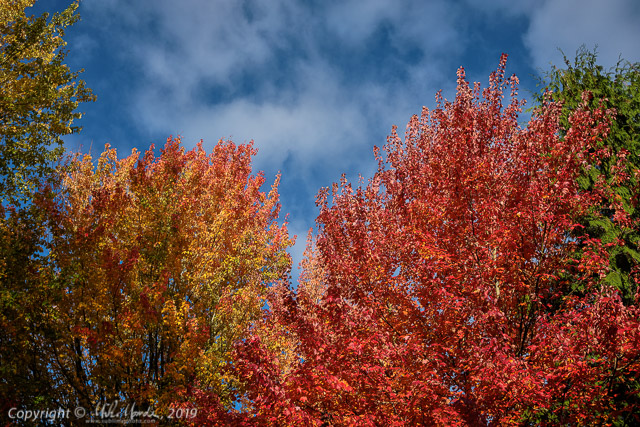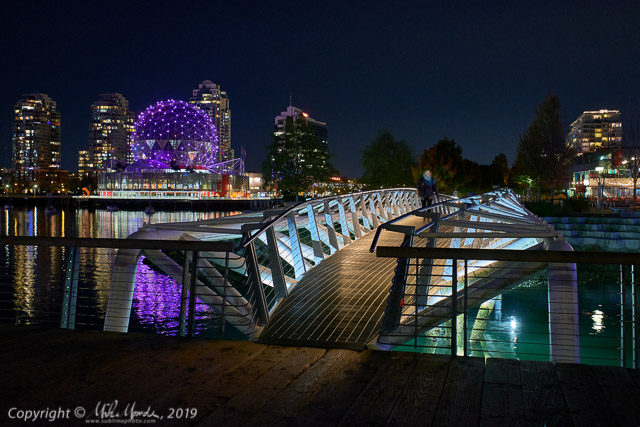Gallery (60 images): X-H1 Night Walk & Fall Colours
Interrupting my posting of Grand Canyon trip images, the above gallery contains two sets of images taken on different days. The first is a walk home from work, along False Creek and through the Olympic Village by Science World. I was shooting with my Fujifilm X-H1 and XF 23mm f/1.4 lens. All the shots were handheld, taking advantage of the X-H1's in-body sensor-shift image-stabilization (IBIS), which can be effective down to as long as a 1 second exposure with something like that 23mm lens. Mind you, reliable 1 second long handheld exposures are still not easy, even with the X-H1's IBIS, but I found a pretty decent hit rate for sharp 1/2 second exposures, and shorter of course. The freedom and speed of shooting that not needing a tripod brings is liberating!
Of course, being completely dark out, I still needed to use ISO 1600 since I also wanted a bit of depth-of-field, deciding to shoot most images at f/4. Had I used a tripod at ISO 200, of course the noise levels would have been less, and the dynamic range and overall image quality would have been better. However, I usually don't decide to walk to work with a tripod, unless I have preplanned a shoot and this was not planned. In short, X-H1 still made it possible to capture rather decent cityscape images in complete darkness, even without a tripod.
Lastly, note that all the images are geotagged, but the X-H1 shots were not tagged in post like I normally do. Instead, I utilized the X-H1's auto-reconnecting Bluetooth interface to my iPhone, and it pulled my location from the phone for each shot. Note that to conserve the battery, I was constantly switching the camera on and off, and at the time I wasn't even concerned with geotagging so didn't give the camera any extra time to connect. In the end, every single shot on that walk home had location data, which is rather convenient!
On my recent trip to Oregon and Idaho, I did use my Garmin Fenix 5 Plus watch to record tracklogs, and then used Lightroom to geotag the images from the X-H1, since I usually didn't have the phone with me. This was the first time I noticed how surprisingly quick and reliable the phone-connection geotagging seems to be was. Cool. That said, some of the X-H1 geotag positions in the above gallery are off by a little more so than I would normally expect, for example, my Garmin to be but I'm not sure if that was due to natural variation in GPS accuracy, or the fact that sometimes I took a shot only a few seconds after flipping the camera on. Maybe if I had waited a little longer after powering up the camera, or just left the camera on between shots, the geotags would have been more accurate?
 The second set of images in the gallery was from my X100F, on the evening I walked to the advance polls for the upcoming Canadian federal election. At the last minute, I decided to grab my Fujifilm X100F on the way out the door and I'm glad I did. Many leaves were already changing colour and with the low evening light, the colours and contrast popped!
The second set of images in the gallery was from my X100F, on the evening I walked to the advance polls for the upcoming Canadian federal election. At the last minute, I decided to grab my Fujifilm X100F on the way out the door and I'm glad I did. Many leaves were already changing colour and with the low evening light, the colours and contrast popped!Clicking on either above image leads to the same gallery, with the first 35 shots being from the nighttime walk with the X-H1, and the last 25 shots the fall colours with the X100F. As mentioned, the X-H1 shots were auto-geotagged but the second set of images from the X100F were tagged manually in Lightroom like I always do. All the images were ultimately processed in Capture One Pro though, not Lightroom. For those X-H1 shots, Lightroom would have yielded cleaner images with less high ISO grain (noise), but at the expense of detail and sharpness in many of the darker areas of the images. Personally, I do prefer the slightly grainier but more detailed images...



0 comments:
Post a Comment